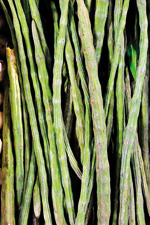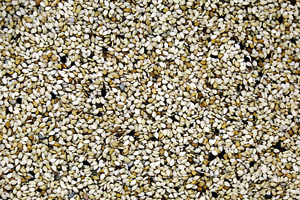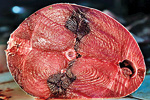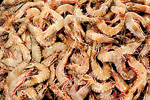Allergies: The known and the little known culprits

Drumstick (murunga)
Annasi, thakkali and isso are the first culprits that come to mind when focusing on allergies which are aplenty these days. No one imagines that there can be an allergic reaction to humble sarana, murunga (drumstick) and even thala (sesame).
“This is the real picture,” says Immunologist Prof. Neelika Malavige who runs the Allergy Clinic along with Immunologist Dr. Chandima Jeewandara both from the Faculty of Medical Sciences of the University of Sri Jayewardenepura.
The Allergy Clinic is located within the Family Practice Centre to the rear of the university at Gangodawila, Nugegoda. A wide range of allergy tests are carried out for a small fee at the clinic.
With an allergy being a disorder caused by an abnormal immune reaction to a harmless substance, such substances or allergens could take different forms.

Sarana
These allergens which bring forth a reaction in some adults and children are found in the air, food, drugs and animals, says Prof. Malavige and may not necessarily be the “usual” pineapple, tomato or prawn.
Pointing out that over the years, allergic reactions seem to be on the rise, Prof. Malavige, however hastens to add that this is a trend seen across the world.

v
Any allergic reaction can be mild or life-threatening, she says, citing the example of how a kadiya-sting can lead to a crisis. A child who was at play during the interval had felt the sting of a kadiya on a finger and flicked her hand which resulted in the insect falling onto her other hand, stinging her again. As the bell summoned the children to class, this little girl felt an itching all over her body. By the time she reached her classroom she was not only vomiting but also writhing with tummy pain.

Fish
“These are life and death situations,” stresses Prof. Malavige, explaining that the child was rushed to hospital and administered with an intramuscular adrenaline injection. The other option for people with severe or life-threatening allergies is to carry the epi-pen which they can inject themselves as soon as they get affected by an allergy and then go to hospital.
Picking up more insect allergies, she says these could include a reaction to mee messa (bee), bambara and debara as well as kaladuru and hath palla stings and occasionally even to mosquito bites.

Pork
The common respiratory diseases due to allergies include asthma and allergic rhinitis. Regrettably, Sri Lanka is right at the top when taking into account asthma-related deaths, she says.
Quoting studies conducted by her on the causes of these respiratory allergies, she says that the house dust-mite is ‘liable’ in about 80% of asthma and allergic rhinitis patients.

Prawn
An interesting finding is also that of the patients studied around 85% were allergic to the house dust-mite, around 47% to cockroaches and around 30% to indoor mould (puss).
Studies by Consultant Respiratory Physician Dr. Anoma Siribaddana of the Kandy Teaching Hospital, meanwhile, has found that some people are prone to respiratory allergies due to pollen from plants and weeds including monara kudumbiya found outdoors.
According to Prof. Malavige in homes, some steps may be taken to rid the environment of the dust-mite such as letting in sunlight and cleaning and wiping down surfaces with a damp cloth regularly. But in a country like ours these measures are not practical. They can also only control but not cure the allergy. However, immunotherapy, not available in Sri Lanka can cure allergies. It seems as if the time is right for the introduction of immunotherapy to the country.

The allergy test clearly indicating a bump for house dust mite. Pix by M.A. Pushpa Kumara
Dealing with food allergies, she points out that they vary from country to country. Unlike in some other countries, nut allergies are not very common in Sri Lanka. Some of the commonest allergies that children here have are to cow’s milk, eggs, wheat and meats such as beef and pork.

Egg
Holding out hope, she says that children outgrow their allergies when they are about 6 or 7 years old or at puberty. The same does not hold true for adults, however, who sometimes develop allergic reactions to seafood and fish and more commonly meats such as beef and pork. Sesame (thala), sarana, murunga and wheat also cause major allergies in adults and last throughout their lives.
Of course, the other common food allergens are tomato, pineapple, mango, wood apple (divul) and banana, as also coconut and brinjal and cereal.
Sometimes these allergies develop suddenly against food these people have been eating all their life. Such allergies could also get aggravated with exertion or alcohol, she says, citing the case of an exercise-induced worsening of a wheat allergy.
| Skin conditions connected to allergy Certain skin conditions such as atopic eczema too could be due to an allergy, says Prof. Neelika Malavige, who adds that while it is not a serious condition there is much agony and suffering for the child. Prof. Malavige allays the fears of parents of children who have atopic eczema by answering some crucial queries. Incidentally, eczema is derived from the Greek word ‘to boil’. n This non-infectious condition manifests itself as red, dry and itchy skin, which can leave in its wake weeping, blistering, crusting, scaling and thickening. Although it can affect the skin all over the body, joints at the elbows, knees and wrists and neck suffer the most. Severe itching could also result in scratches. According to Prof. Malavige studies in other countries indicate that the main allergen for atopic eczema is house dust mite, while cow’s milk and eggs could also cause this condition. “However, it is important to determine what causes atopic eczema without depriving all the children who have this condition from consuming cow’s milk and eggs which are not only found in a large majority of food but are also necessary for growth,” she says, adding that heat, which cannot be avoided in a tropical country like Sri Lanka, could also aggravate this skin issue. Even though atopic eczema cannot be cured, Prof. Malavige says that it can be controlled. The silver lining is that the condition gradually improves as the child grows older and in a large majority it gets cleared by the time they reach their teens. | |


